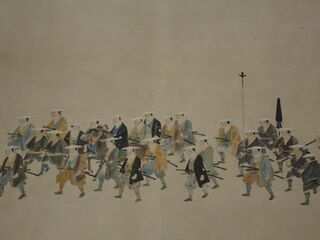Odagiri Shunko

- Born: 1810
- Died: 1888/10/19
- Other Names: 歌月庵 (Kagetsuan), 喜笑 (Kishou), 小田切忠近 (Odagiri Tadachika), 小田切伝之丞 (Odagiri Dennojou)
- Japanese: 小田切春江 (Odagiri Shunkou)
Odagiri Shunkô was a samurai and court painter in service to the Tokugawa lords of Owari han (Nagoya) in the late Edo and early Meiji periods.
Shunkô was one of his art-names (gô); the other was Kishô, while his given name was Tadachika, and he was also known as Dennojô.
Born the eldest child of Odagiri Matsusaburô, a samurai retainer to the Owari Tokugawa clan, he received a regular stipend of 100 koku.
He studied under Kôriki Tanenobu, illustrating secondary copies of Tanenobu's books, as well as producing his own for the booklender Ônoya Sôhachi, before beginning study under Mori Kôga, a specialist in color. He served in a number of low- to mid-ranking positions, including as umamawari (guard), shoinban (guard of the study), and other positions. In 1865, he produced two significant paintings at the order of the domain: Owari shi and Mino shi. Along with Okada Kei he also produced the Owari meisho zue, a collection of famous places of the Owari area. His other works include Owari eiketsu gaden, a handscroll painting of the lord's sankin kôtai procession, and a number of maps of Owari and other provinces, as well as works depicting the Ryukyuan embassies to Edo, including the Ryûkyû gashi and Meiyô kenbun zue.
References
- "Odagiri Shunkô," Nihon jinmei daijiten 日本人名大辞典, Kodansha 2009.
- Yokoyama Manabu 横山学, Ryûkyû koku shisetsu torai no kenkyû 琉球国使節渡来の研究, Tokyo: Yoshikawa kôbunkan (1987), 211-212n18.